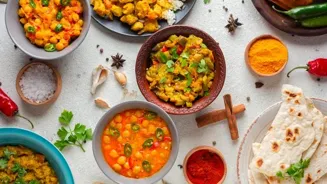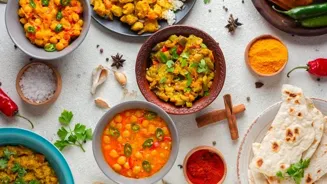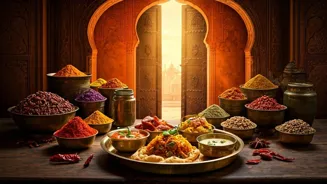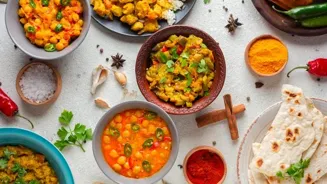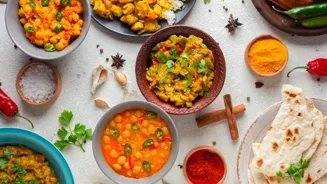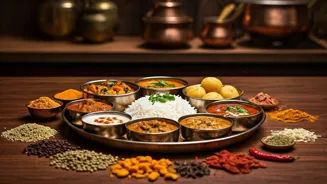Discover the irresistible world of Indian sweets, intertwined with traditions and celebrations. Dive into the sweetest part of India's culture!
India, a land known for its vibrant culture and traditions,
finds a special place for sweets in almost every aspect of life. From the joyous celebrations of festivals to the simple act of sharing happiness, mithai, or sweets, are an integral part of the Indian experience.
It's difficult to imagine weddings without perfectly swirled jalebis, or festivals without the colorful display of barfi and laddoo. Sweets are more than just food, they're a symbol of good fortune, a gesture of goodwill, and a way to express love and affection.
Each region boasts its unique sweet creations, passed down through generations, making the world of Indian sweets incredibly diverse and intriguing for everyone.
Sweets central to Indian festivals, fostering togetherness and joy
The presence of sweets is essential in most Indian festivals, marking the significance of the occasion and raising the festive spirit. Diwali, the festival of lights, is incomplete without the distribution of sweets amongst family, friends and neighbors.
Every household prepares or purchases a variety of sweets – from the rich and decadent kaju katli to the melt-in-your-mouth besan laddoo. Eating together and sharing these sweets fosters a sense of togetherness and strengthens the bonds between people.
Similarly, during Holi, the festival of colors, thandai, a milk-based drink flavored with nuts and spices is enjoyed with sweets like gujiya, a deep-fried dumpling filled with sweet mixtures.
These culinary traditions are also about experiencing the flavour of the festival and ensuring a very happy one for all!
Indian sweets symbolize blessings in rituals and celebrations
Sweets play a pivotal role in many Indian rituals and ceremonies, signifying auspicious beginnings and blessings. At weddings, the bride and groom often exchange mithai in a traditional ceremony, symbolizing the sweetness and prosperity they hope to achieve in their married life.
Ganesh Chaturthi, a festival dedicated to Lord Ganesha, involves offering modaks, a sweet dumpling made of rice flour and jaggery. It shows respect and devotion. Birthdays and other important milestones are celebrated with the distribution of sweets, wishing the person good health and happiness.
Many families also believe that starting a new venture or undertaking a new project with something sweet brings good luck and success.
Regional diversity of Indian sweets reflects unique flavors, preparation methods, and cultural identity
The regional diversity of India is reflected in its vast array of sweets, each with its unique flavour and preparation methods.
From the North's creamy peda and rich gajar ka halwa to the South's Mysore pak and payasam, every region has its signature sweets that are deeply rooted in its culinary heritage.
West Bengal is renowned for its milk-based sweets like rasgulla and sandesh, while Rajasthan offers treats like ghewar, a disc-shaped sweet made during Teej, the monsoon festival.
These regional sweets not only offer a glimpse into local ingredients and cooking techniques, but also showcase the cultural identity of each state. Exploring this varied world of Indian sweets is a journey through the country's rich history and traditions.
Making traditional Indian sweets preserves cultural heritage through family recipes and bonding
Making traditional Indian sweets is a skill that is often passed down through generations, with grandmothers and mothers carefully guiding younger family members. The recipes are more than just a list of ingredients, they are stories of family history and culinary secrets.
Every step, from measuring ingredients to stirring the mixture, is an act of love and tradition. These family recipes are not only important for their taste, but also for preserving cultural heritage.
Often, these traditional methods and culinary heritage are combined with the use of kitchen equipments that are innovative – this ensures that future generations carry forward the legacy of making sweet treats with passion and care.
The time spent together in the kitchen is an opportunity for bonding, sharing memories, and creating new ones.
Sweets symbolize hospitality, kindness, and community in Indian culture
Beyond celebrations, sweets also play a role in everyday life, serving as a simple gesture of hospitality or a way to express kindness. Offering a guest a piece of mithai is a common practice in Indian households, symbolizing warmth and welcome.
Sharing sweets with neighbors or colleagues is a way to build relationships and foster community spirit. Even a small piece of jaggery or a handful of roasted chana (gram) can be a comforting snack, reminding people of their roots and traditions.
The act of sharing sweets, whether during festivals or in everyday interactions, is a reflection of the Indian culture emphasizing relationships, generosity, and creating a sense of community.
AI Generated Content. Glance/InMobi shall have no liability for the content